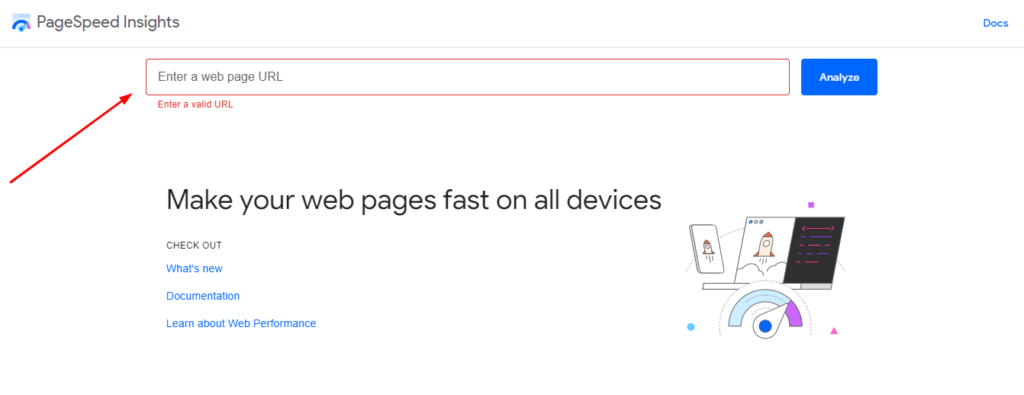You can do a few easy actions to enhance your website’s performance if you want to increase its speed. Specifically, you should look for slow-load files and fix them to improve your site’s PageSpeed index ranking. Here at Towards Digital Skills Writings, we will tell you about the Steps to Optimize Your Site Using Google PageSpeed Insights Tool.
Check the functionality of your website:
Using the Google PageSpeed Insights Tool, you can assess how well your website performs. Compared to other methods, it gives more accurate information about page loading times. The score is determined by averaging various variables in a weighted manner. A metric will have a more significant effect on the total grade if it is heavily weighted. The tool also provides suggestions for improving the performance of your website.
The program combines both laboratory and real-world data to identify performance issues. For example, the tool can show the load time of a page when mobile users with desktop computers view it. A high PageSpeed score means that the page loads faster than the average page, and a low score is a good sign.

Conversion rates are significantly impacted by how quickly your page loads. Nobody wants to wait for a page to load for more than ten seconds. The Google PageSpeed Insights tool will identify any speed issues and suggest solutions to make your site faster. These fixes may include compressing images, minifying code, adding browser caching, or implementing AMP.
The tool is made to assess how quickly your website loads in comparison to its rivals. The device uses various factors to calculate a score and make recommendations on improving your site’s speed. A page with an 85 or higher score is considered to be a high-performing page.
The tool offers thorough information and is free to use. Both beginners and experts can utilize it. It includes a simulated desktop screen to help analyze your website’s performance.
Find slow-loading files:
Google PageSpeed Insights is a helpful tool for website owners. While it can be tempting to focus on optimizing your website for a perfect 100/100 score, this is often unnecessary. Instead, it would help if you focused on implementing the tool’s recommendations and making your page as fast as possible.
Downloading and using the tool are both free. Entering your website’s URL is all that is necessary to analyze its loading time. From there, you can get a detailed report of your website. It will list issues and provide tips on how to improve them.
An innovative strategy to optimize your website for performance and ranking is to use Google PageSpeed Insights. You can use server-side caching and compression to reduce the size of web pages. Another way to make a page faster is to remove non-uniform formatting and unused code.

PageSpeed Insights can also help you optimize images. It suggests using tools like ImageResize and TinEye Reverse Image Search to compress images and minimize their size. Those tools can reduce pictures by up to 80%. You should also check out the page’s loading time by using these tools.
Google PageSpeed Insights reports a site’s speed by examining a few different metrics. The first is the server response time. This metric is not official, but it measures the time the website takes to send the first byte after a request. If this value is high, the page will be slower to load.
Although this program is free, it can be challenging to use. Fortunately, it tells you what actions to take for each setting, which can help improve your page’s speed.
Could you fix them?
If you’re running a website and want to improve the speed of your pages, you’ll need to check your page speed. The Google PageSpeed Insights Tool can tell you how your page performs and give you some optimization suggestions. You can increase page performance and user experience by using this tool.
The Google PageSpeed Insights tool uses the Lighthouse tool to analyze web pages for performance issues. The tool collects lab and field data to determine what’s causing problems and where you can fix them. The lab data is gathered in a controlled setting and is particularly beneficial in figuring out performance problems. The field data is collected from real visitors and can show issues you might not be aware of.

A slow-loading web page can turn off users and discourage leads. In addition to this, a slow-loading page can also negatively impact SEO. A fast-loading page will create a good impression with the visitor and encourage them to stay on your website.
Improve its ranking on Google’s PageSpeed Index:
If you want your web page to rank well on Google’s PageSpeed Index, you must ensure that it loads as quickly as possible. Slow web pages will not retain visitors for a very long and likely bounce off your site. Google PageSpeed Insights is a free tool that can help you do that. It analyzes the performance of your web page on desktop and mobile devices and provides practical recommendations on how to improve page loading time. This tool is simple to use and intuitive. It uses information from the Chrome browser’s user experience report to calculate the speed of your web page. Its purpose is to promote fast web pages for search engine optimization and improve user experience.

PageSpeed Insights is a free tool to help website owners, developers, operators, and optimizers improve their pages. The device helps determine whether your website performs well in Google’s search rankings. A site that loads too slowly is unlikely to convert visitors into buyers, making Google’s algorithms more likely to penalize the site.
Google PageSpeed Insights uses the open-source Lighthouse framework to evaluate web page performance, and it provides publishers feedback on optimizing their scripts for maximum performance. By analyzing the performance of web pages by URL, the tool reveals factors that are crucial to Google’s search algorithm and makes recommendations based on the latest industry best practices.
While Google PageSpeed Insights is an excellent free tool for analyzing your website’s performance, it does have its limitations. The test is performed at an unknown location, and you must be connected to 3G or higher to run the test. The results are based on an algorithm that compares your web page with Google’s PageSpeed index best practices, and scores range from 0 to 100. Your site will rank higher for linked keywords the more elevated the PSI score.
With the use of a content delivery network, track its performance:
The digital experience would not be possible without a content delivery network or CDN. Many organizations use several CDN providers and utilize geo-specific routing. While these approaches are helpful, they are not sensitive, robust, or agile enough to detect and respond to CDN incidents in real-time. One-second delay can cost an online business up to 7% of its customer conversions. To combat this problem, you need a CDN monitoring solution that is AI and machine learning (ML)-based.
A CDN is a technology that allows websites to distribute material more quickly and securely. It is used to manage traffic and improve a business’ technological infrastructure. It is essential to pick a CDN provider with servers in your targeted markets. Choosing a provider based on its reputation for speed and reliability may be best. Larger organizations tend to use faster networks than smaller ones.

Another benefit of using a content delivery network is that it can better respond to spikes in traffic. This can occur due to a successful marketing campaign, limited-time offer, or viral video. By distributing the traffic to multiple servers, a content delivery network can prevent the spikes from impacting website performance. Moreover, a content delivery network can help you detect man-in-the-middle attacks, DDoS attacks, and firewall problems.
The performance of a CDN can be measured by running synthetic monitoring tests in multiple locations. This will allow you to compare the CDN’s performance with its origin. This comparison can be made using different performance metrics, such as webpage response time. This can help you make the most effective content mapping.






















































